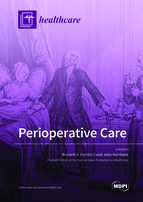Perioperative Care
A special issue of Healthcare (ISSN 2227-9032). This special issue belongs to the section "Perioperative Care".
Deadline for manuscript submissions: closed (28 February 2021) | Viewed by 44165
Special Issue Editors
2. Clinical Associate Professor (affiliate), School of Pharmacy, Virginia Commonwealth University, Richmond, VA 23298, USA
Interests: pharmacy pediatrics; perioperative care; medication management; health informatics; clinical administration
Special Issues, Collections and Topics in MDPI journals
Special Issue Information
Dear Colleagues,
Perioperative care practices worldwide are in the midst of a sea change with the implementation of multidisciplinary processes that improve surgical outcomes through (1) better patient education, engagement, and participation, (2) enhanced pre-operative, intra-operative, and post-operative care bundles, and (3) interactive audit programs that provide feedback to the surgical team. These improved outcomes include reduction in the frequency and severity of complications and improved throughput that ultimately reduce operative stress. Practices in theatre as well as ward are becoming more collaborative and evidence-driven.
In this Special Issue, all professions involved in periprocedural areas are encouraged to “tell their stories” through practice-based research activities, descriptions of changes in resource utilization, and lessons learned in programmatic change management and implementation science. In addition, we welcome reports that demonstrate the impact of innovations in surgical procedures, application of new technologies and materials, and multidisciplinary collaboration in sustaining perioperative performance measures.
Dr. Richard H. Parrish II
Prof. Dr. John Kortbeek
Guest Editors
Manuscript Submission Information
Manuscripts should be submitted online at www.mdpi.com by registering and logging in to this website. Once you are registered, click here to go to the submission form. Manuscripts can be submitted until the deadline. All submissions that pass pre-check are peer-reviewed. Accepted papers will be published continuously in the journal (as soon as accepted) and will be listed together on the special issue website. Research articles, review articles as well as short communications are invited. For planned papers, a title and short abstract (about 100 words) can be sent to the Editorial Office for announcement on this website.
Submitted manuscripts should not have been published previously, nor be under consideration for publication elsewhere (except conference proceedings papers). All manuscripts are thoroughly refereed through a single-blind peer-review process. A guide for authors and other relevant information for submission of manuscripts is available on the Instructions for Authors page. Healthcare is an international peer-reviewed open access semimonthly journal published by MDPI.
Please visit the Instructions for Authors page before submitting a manuscript. The Article Processing Charge (APC) for publication in this open access journal is 2700 CHF (Swiss Francs). Submitted papers should be well formatted and use good English. Authors may use MDPI's English editing service prior to publication or during author revisions.
Keywords
- Perioperative care
- Surgery
- Operating room nursing
- Anesthesiology
- Clinical pharmacy
- Allied health
- Collaborative practice
- Performance improvement








